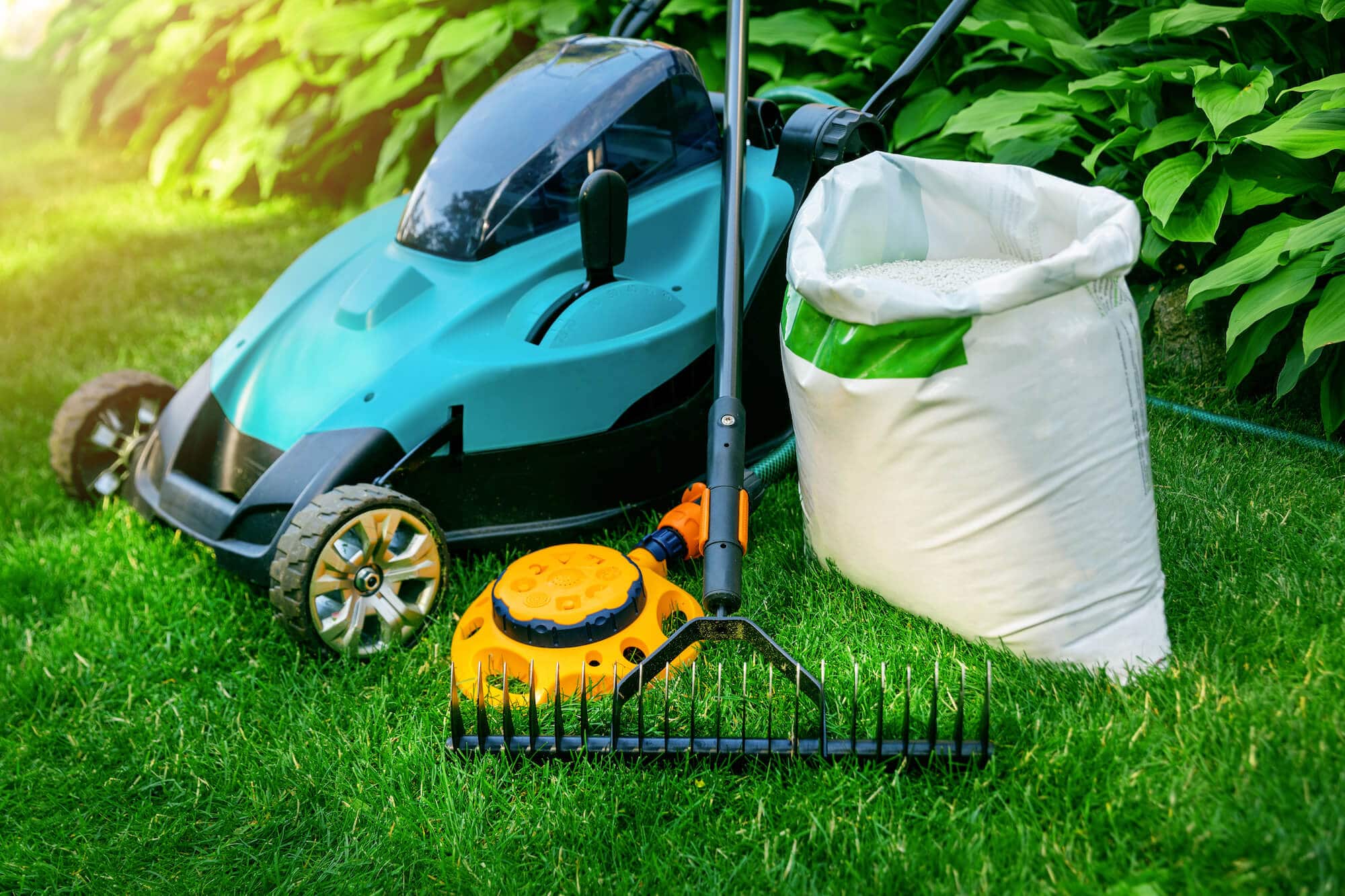Comprehensive Lawn Care Schedule for the Whole Year
Earning the accolade of the greenest lawn in the neighborhood requires a bit more than an occasional mow in the height of the summer season. By understanding the annual cycles of grass, weeds, thatch, and soil, homeowners can keep their lawn looking and growing heartily no matter what the weather brings.
Most importantly, you should always begin by exploring what makes your lawn unique. Your region’s hardiness zone and year-round climate have as much to do with its health as your habits.
The different varieties of grass in your lawn will often feature a mixture of types ideal for your region’s temperature and moisture levels. Some areas throughout the country are also more prone to pests, overgrown thatch, and dry patches in the height of the season, for example.
Mark your calendar with the help of our month-by-month lawn care guide to keep your landscape healthy both off-season and on.

Spring Lawn Checklist
As winter finally wraps up, the ground will start to thaw all the debris from the fall and winter must be cleaned away to prepare for the upcoming season. The warm weather also brings with it a sense of motivation to start fresh and ensure all your equipment and materials are ready to go for the peak months ahead.
March and Early April
These first two months are all about preparation. If you have a particularly cold start to the spring—especially if you live in a colder climate—hold off on any seeding until you’re sure the final frost is a couple of weeks behind you.
1. Spruce Up Your Tools
Your mower, weeder, and hand tools could use an update after overuse from the end of last fall. We recommend taking your mower for a professional tune-up where they can sharpen your blades, replace any decaying parts, and check your motor.
Is it time to purchase new hand-held tools, fertilizer or topsoil? Catch the start-of-the-season sales to ensure you’re prepared for the height of planting season.
2. Clear Away Debris
Clear your lawn of remaining branches, decaying leaves, or general debris brought in during the winter. This will allow you to assess where your grass needs special attention before diving in. Note any yellow or brown patches for further assessment.
3. Aerate and Dethatch
Take a close look at how your grass fared during the winter months. Does it look compacted from snow and foot traffic? How about the layer of thick thatch between the grass and the soil?
Aeration is the process of removing small cores of soil from your lawn to break up compacted soil and allow moisture, air, and sunlight to permeate the earth. This process is typically completed about once a year at the beginning of the season.
During this process, you should get a good sense of the amount of thatch in your lawn. Thatch is natural and necessary for healthy lawn growth. You can spot it by looking closely at one of the removed cores of grass and soil during aeration or by removing a small subsection with a corer and spade.
If the layer of organic material between the base of your grass and the soil has grown beyond a half-an-inch, we recommend using a dethatching rake across the lawn. This process allows more air and sunlight into the base layer to discourage pests, disease, and brown patches from forming.
Late April and May
As the weather warms up and precipitation increases, common nuisances like weeds, pests, and fungus begin to re-emerge. This stage of the spring is all about checking in on your soil, patchy spots in your grass, and how to protect your lawn from any threats during the peak of the season.
1. Check Your Soil
A soil’s pH levels can be the key to detecting what your lawn needs. Speak with a professional for a simple pH test or purchase a DIY kit at your local landscape or hardware store. You should aim for a soil pH between 6.5 and 7, otherwise, it may be necessary to adjust your fertilizer.
2. Continue with Fertilization
Once you know the state of your soil, choose a fertilizer that balances your soil’s pH and matches your variety of grass. Throughout the year, May and September are ideal for adding a layer of fertilization. In the spring, the start of the season fertilization is best when the weather consistently warms up and stabilizes.
Be sure to choose a fertilizer for either cold or warm-weather grasses and stick with a slow-release variety for best results.
3. Get Ahead of Weeds
Pre-emergent weed applications protect from the overgrowth of things like crabgrass, dandelions, and other invasive culprits before they take off at the end of spring. Depending on your region, pre-emergents can be used anywhere between Mid-April to the start of May, usually when your soil has reached the upper 50s.
Summer
The long hot days of summer require a consistent watering and mowing schedule to keep your lawn looking fresh and weed-free. Grass that is too tall and thick welcomes pests to burrow and reproduce while grass that is too short doesn’t give the roots a chance to strengthen. Check out these summer tips to keep your grass lawn happy in the height of the season.
June-Early August
Since summer weather remains rather consistent through early August, a simple regimen and troubleshooting plan is all you need to keep your lawn happy and healthy.
1. Water in the Mornings
By now, the sun will be too hot by mid-morning for watering, so stick to the early hours before the air heats up. No need to overwater—every other day should do to moisten the top layer of soil.
Depending on your region’s heat, you only need about ⅓ of an inch of water each time, just enough to keep the ground from drying out. If you live in an area prone to drought, be sure to stick with local water-usage regulations.
2. Mow for Optimal Height
Maintaining the right height for your grass can be tricky in the summer, especially when it comes to grass varieties that grow very quickly. Set your mower between three and three-and-a-half inches for best results. This will depend, however, on the type of grass in your lawn as well as the climate in your region.
Whenever possible, it’s best to only remove the top third of each blade of grass, so try to stay in a regular mowing schedule. It’s also beneficial to leave your grass clippings on the lawn if you have a regular mowing schedule.
3. Treat for Common Pests
An overabundance of grubs—the larvae of Japanese beetles—are one of the largest culprits for problems with your lawn in late summer. Grubs can feast on grass roots and material in your thatch, killing the grass in these patches.
A balanced number of grubs—usually less than 10 per square foot—is nothing to worry about. However, if you spot more than this in a given section, consider treatment in mid-to-late summer.
Chemical, organic, or integrative grub control is important if you detect an issue. For example, encouraging the natural grub predator population, such as birds, moles, and skunks, is a good way to keep an eye on pest control without annual treatment.
Fall
Much like the spring, the autumn is a time to give extra-special attention to feeding your grass and checking in on the health of your soil. Cool-season grasses need specific care, especially as they prepare for the frost.
September through Mid-October
Frequent traffic throughout the summer could have led to compacted soil and lowering temperatures mean that the grass’s roots need extra nutrients. Here are a few steps for wrapping up your lawn before the cold weather arrives.
1. Fertilize Cool-Season Grasses
Bluegrasses, rye, and other cold-weather grasses benefit from a layer of fertilizer in late September after temperatures have begun to cool. This helps prepare it for the cold winter ahead when it goes dormant.
2. Aerate and Overseed
If you have patchy grass or overgrown thatch like the spring, complete another pass with your aerator and dethatching rake.
This is also an ideal time to begin the overseeding process. The cooler temperatures and lack of fast-growing weeds take the pressure off your grass, making this an easier time to fill in empty spots than in the summer.
After identifying the grass in your lawn, spread the seed liberally in patchy areas and lightly rake the grass to incorporate the seeds with the soil. Water regularly and avoid foot traffic as it germinates.
3. Adjust Your Mower Blades
Shorter grass is more beneficial in the colder months, especially as leaves begin to fall and snow is on the way. Lower your mower blades to between one and one-and-a-half inches to prepare it for the winter months.
Mid-October to November
As leaves begin to fall and winter is on the horizon, shift your regimen toward keeping your grass clear and tools prepared for the upcoming cold season.
1. Keep Your Grass Clear
While some leaves will break down to nourish your soil over time, too think a layer will keep the sun, water, and air from reaching the grass’s roots. Rake or blow your leaves and remove the pile to discourage pests and small animals from building a home.
2. Transition Your Tools
Clean off any hand or power tools from the summer and fall and ensure that they are stored in a winter-ready location to avoid rusting or decay. If you experienced any issues with your mower over the summer, have the issue looked at before closing up the season.
Take a moment to check on your snow blower, shovels, and de-icing materials for the first snowstorm as well.
3. Remove Any Final Weeds
Check your landscape for any final weeds hanging on to ensure that you start the spring fresh without anything to hold back a lush and green lawn.
Winter
The colder months are the ideal time to let your lawn rest from foot traffic and unnecessary landscaping as much as possible. Your dormant grass is more likely to thrive with minimal interruption during this low season.
December-February
All the steps that you took during the fall—fertilization, overseeding, and leaf removal—will set your lawn up for a safe and healthy winter. Here are two common tips for keeping your lawn safe as the weather cools.
1. Mind Your Deicing Treatments
Some sidewalk and driveway deicing formulas are damaging to grass and plants. When spreading these materials, avoid spreading them over the edge of the lawn or plant beds, even if these are covered in snow.
2. Tread Lightly on Your Lawn
Avoid putting extra pressure on your winter grass and soil to avoid dead patches in the spring. This can occur both from foot traffic and from placing heavy items on your lawn, such as firewood piles or from parking snow blowers.
Year-Round Expert Support
Life gets busy so it isn’t always possible to handle the year-round checklist on your own. With a professional landscape team at the ready, you can leave trickier treatments to the pros such as overseeding, aeration, and soil tests.
TruGreen offers eco-conscious lawn care services catered to your time, budget, and unique landscape. From grass health to tree and shrub expertise, your local TruGreen team is here to answer all your seasonal questions, especially if you encounter problems that are hard to identify.
Above all, TruGreen’s local teams understand the importance of lending regional experience and tailored expert advice to every homeowner. Reach out to a specialist at TruGreen today for a free estimate and tips on how we cater our services to your unique lawn.







